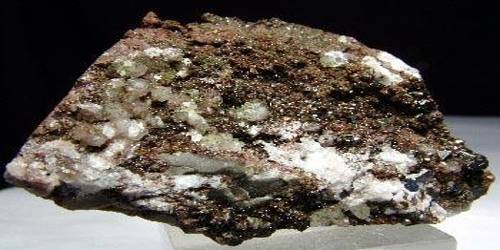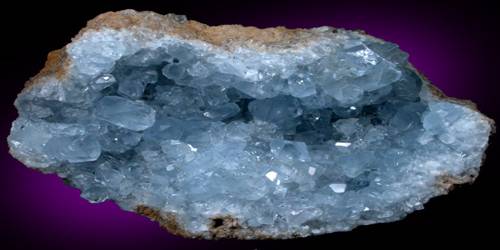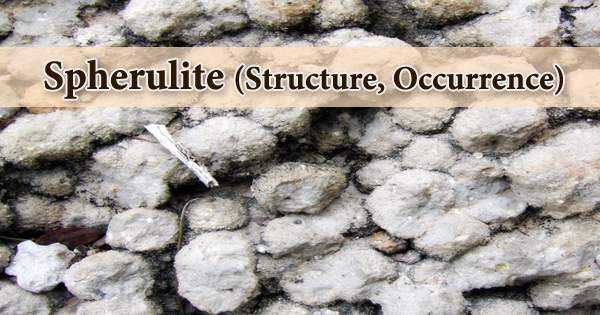Definition –
“Chrysoberyl” is a hard, tough, and durable gem, and it is an aluminate of beryllium with the formula BeAl2O4. It is distinctly different from the beryllium-aluminum silicate (Be3Al2(SiO3)6 mineral known as “beryl,” although the similar names can cause confusion.
The name chrysoberyl is derived from the Greek words χρυσός chrysos and βήρυλλος beryllos, meaning “a gold-white spar”. Despite the similarity of their names, chrysoberyl and beryl are two completely different gemstones, although they both contain beryllium. Chrysoberyl is the third-hardest frequently encountered natural gemstone and lies at 8.5 on the Mohs scale of mineral hardness, between corundum (9) and topaz (8).
Chrysoberyl is not found in deposits that are large enough to allow it to be used as an ore of beryllium. Its only important use is as a gemstone; however, it excels in that use because of its very high hardness and its special properties of chatoyance and color change.
An interesting feature of its crystals are the cyclic twins called trillings. These twinned crystals have a hexagonal appearance, but are the result of a triplet of twins with each “twin” oriented at 120° to its neighbors and taking up 120° of the cyclic trilling. If only two of the three possible twin orientations are present, a “V”-shaped twin results.
Although lacking the fire of other gemstones, Chrysoberyl in its various forms can be quite valuable. Most Chrysoberyl gems are yellow, though some are brown, green, or orange. Chrysoberyl is best known for its important varieties Alexandrite and Cat’s Eye. Alexandrite is a rare and expensive form that exhibits different colors in natural and artificial light. Cat’s Eye is Chrysoberyl that is polished into a cabochon and highly chatoyant, displaying a sharp line of light through the center of the stone.
Ordinary chrysoberyl is yellowish-green and transparent to translucent. When the mineral exhibits good pale green to yellow color and is transparent, then it is used as a gemstone. The three main varieties of chrysoberyl are: ordinary yellow-to-green chrysoberyl, cat’s eye or cymophane, and alexandrite. Yellow-green chrysoberyl was referred to as “chrysolite” during the Victorian and Edwardian eras, which caused confusion since that name has also been used for the mineral olivine (“peridot” as a gemstone); that name is no longer used in the gemological nomenclature.
Occurrence and Properties of Chrysoberyl –
Chrysoberyl is best known for its use as a gem. There are multiple varieties of gem chrysoberyl, each with its own name and unique physical properties. Ordinary chrysoberyl is a yellow to yellow-green to green gemstone with a translucent to transparent diaphaneity. Transparent specimens are usually cut into faceted stones. Specimens that are translucent or with silk are usually cut into cabochons.
Chrysoberyl forms as a result of pegmatitic processes. Melting in the Earth’s crust produces relatively low-density molten magma which can rise upwards towards the surface. As the main magma body cools, water originally present in low concentrations became more concentrated in the molten rock because it could not be incorporated into the crystallization of solid minerals. The remnant magma thus becomes richer in water, and also in rare elements that similarly do not fit in the crystal structures of major rock-forming minerals. The water extends the temperature range downwards before the magma becomes completely solid, allowing concentration of rare elements to proceed so far that they produce their own distinctive minerals. The resulting rock is igneous in appearance but formed at a low temperature from a water-rich melt, with large crystals of the common minerals such as quartz and feldspar, but also with elevated concentrations of rare elements such as beryllium, lithium, or niobium, often forming their own minerals; this is called a pegmatite. The high water content of the magma made it possible for the crystals to grow quickly, so pegmatite crystals are often quite large, which increases the likelihood of gem specimens forming.
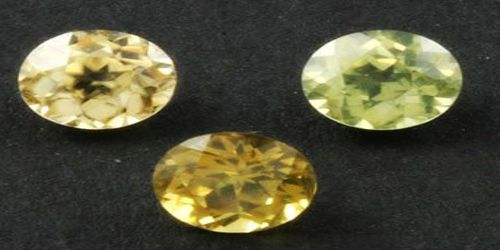
(Chrysoberyl: a gem mineral is known as cat’s-eye and alexandrite)
The most significant Chrysoberyl deposits are in Brazil, but other important deposits are in Australia, Madagascar, Zimbabwe, Myanmar (Burma), and Russia. Cat’s eye is found in Brazil, India, China, Sri Lanka, and Zimbabwe, and Alexandrite comes from Brazil, Russia, Madagascar, Sri Lanka and Tanzania. Chrysoberyl is also found along with other gem minerals in placer deposits. It is a hard, weathering-resistant mineral with a high specific gravity. These properties allow it to survive in sediments after other minerals have been destroyed by abrasion and chemical weathering.
Chrysoberyl can also grow in the country rocks near to pegmatites, when Be and Al-rich fluids from the pegmatite react with surrounding minerals. Hence, it can be found in mica schists and in contact with metamorphic deposits of dolomitic marble. Because it is a hard, dense mineral that is resistant to chemical alteration, it can be weathered out of rocks and deposited in river sands and gravels in alluvial deposits with other gem minerals such as diamond, corundum, topaz, spinel, garnet, and tourmaline. When found in such placers, it will have rounded edges instead of sharp, wedge-shape forms.
Chrysoberyl is most often a lightly colored gemstone, though increased color saturation will increase its value. Chrysoberyl gemstones are often free of flaws, though stones larger than several carats are uncommon. With a hardness of 8½, Chrysoberyl is also one of the hardest gemstones. The term “Cat’s eye” when used alone without any gemstone name prefix will always refers to Chrysoberyl Cat’s eye, which is the most famous and valuable of the cat’s eye gemstones. All cat’s eye gemstones other than Chrysoberyl must be designated by their gemstone name, such as “Tourmaline Cat’s eye”, or Cat’s Eye Tourmaline.
Chrysoberyl is the gemstone that produces the most distinct “cat’s-eye,” or chatoyance. If a person uses the name “cat’s-eye” without the name of another gemstone (for example, “cat’s-eye tourmaline”), then he is most likely referring to chatoyant chrysoberyl. Cat’s-eye chrysoberyl has also been called “cymophane.”
Alexandrite is one of the rare color change crystals and is translucent. The alexandrite variety displays a color change dependent upon the nature of ambient lighting called metamerism. Metamerism is the phenomenon of an observed color change from greenish to reddish with a change in source illumination. Alexandrite results from small scale replacement of aluminium by chromium ions in the crystal structure, which causes intense absorption of light over a narrow range of wavelengths in the yellow region (580 nm) of the visible light spectrum.
Alexandrite is a rare material, only found in very small deposits. It was first discovered in the Ural Mountains of Russia in the late 1800s. Although that deposit has been mined out, small deposits have since been discovered in Brazil, India, Sri Lanka, Myanmar, China, Zimbabwe, Tanzania, Madagascar, Tasmania, and the United States.
According to a popular but controversial story, alexandrite was discovered by the Finnish mineralogist Nils Gustaf Nordenskiöld (1792-1866), and named alexandrite in honor of the future Tsar Alexander II of Russia. Nordenskiöld’s initial discovery occurred as a result of an examination of a newly found mineral sample he had received from Perovskii, which he identified as emerald at first. The first emerald mine had been opened in 1831.
One of the most distinctive properties of chrysoberyl is its exceptional hardness. With a Mohs hardness of 8.5, it is the third-hardest gemstone and the third-hardest mineral that is even occasionally found at Earth’s surface. Although chrysoberyl is extremely hard, it does break with distinct cleavage in one direction and indistinctly or poorly in two others. It also has a brittle tenacity.
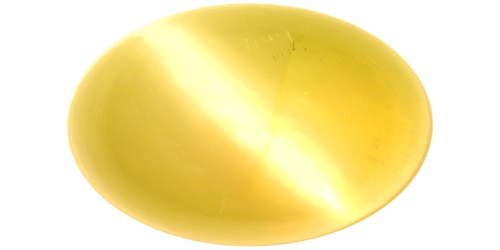
(Fine-color cymophane with a sharp and centered eye)
Translucent yellowish chatoyant chrysoberyl is called cymophane or cat’s eye. Cymophane has its derivation also from the Greek words meaning ‘wave’ and ‘appearance’, in reference to the haziness that visually distorts what would normally be viewed as a well defined surface of a cabochon. This effect may be combined with a cat eye effect. In this variety, microscopic tubelike cavities or needle-like inclusions of rutile occur in an orientation parallel to the c-axis, producing a chatoyant effect visible as a single ray of light passing across the crystal. This effect is best seen in gemstones cut in cabochon form perpendicular to the c-axis. The color in yellow chrysoberyl is due to Fe3+ impurities.
Although other minerals such as tourmaline, scapolite, corundum, spinel and quartz can form “cat’s eye” stones similar in appearance to cymophane, the jewelry industry designates these stones as “quartz cat’s eyes”, or “ruby cat’s eyes” and only chrysoberyl can be referred to as “cat’s eye” with no other designation.
Most specimens of chrysoberyl are nearly colorless or fall into the brown to yellow to green color range. Red specimens are occasionally found.
Uses and Benefits of Chrysoberyl –
All colors of transparent Chrysoberyl can be faceted into gemstones. Despite its appealing and valuable nature, Chrysoberyl is not extensively used in jewelry. The most common colors for Chrysoberyl jewelry are yellow, greenish-yellow, and brownish-yellow. Cat’s Eye is polished into cabochons, and usually has a yellow-brown, greenish-brown, greenish-gray, or gray color. Alexandrite is used as rare and exquisite jewelry piece, and most often faceted into round and cushion cuts that are used in rings and pendants.
Cat’s eye became significantly more popular by the end of the 19th century when the Duke of Connaught gave a ring with a cat’s eye as an engagement token; this was sufficient to make the stone more popular and increase its value greatly. Until that time, cat’s eye had predominantly been present in gem and mineral collections. The increased demand in turn created an intensified search for it in Sri Lanka.
Alexandrite is good for regenerating enthusiasm and will protect people if they are travelling in mountainous or hill country. It will help healers not to become overloaded by the troubles or negative energies of others. Alexandrite brings in the frequency of joy. It teaches you to see the joy in being an embodied soul. Resonating with this stone may assist you in dealing with issues of not being able to receive love or energy from others. It can assist people in learning to trust their intuition and guidance and in opening to become a channel for Divine knowledge and love.
Alexandrite is also used for channeling wisdom from devas, the higher nature essences and from the guardians of mountains. Alexandrite allows connection with the frequencies of Divine Knowledge and Divine Love. It assists people in resonating with these frequencies and using them to gather knowledge for the growth of the self or others while sharing this knowledge from the heart. It facilitates the recovery of alternate life information and Akashic records.
Information Sources:

